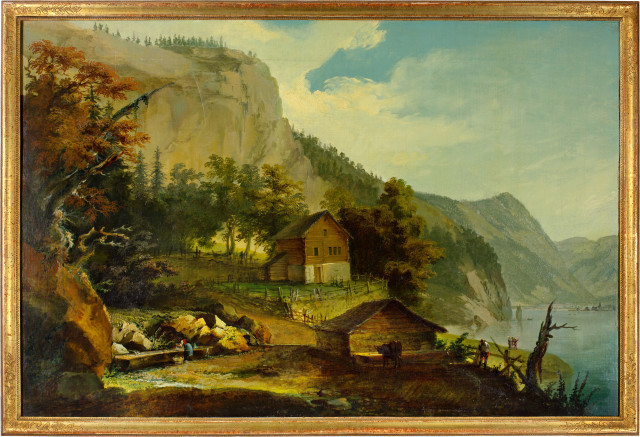- EN
Log in
- Gallery
- Art Dealing
- Publishing
- Kornfeld today
- The Story of Kornfeld
- Information




Muri 1735 - 1783 Heidelberg
circa 1775
Oil on canvas
54x82 cm
Signed by the artist in oil paint on the right-hand well trough "C. Wolf"
Willi Raeber, Caspar Wolf 1735-1783, Sein Leben und Werk, Aarau 1979, no. 213
Abraham Wagner, Bern
Gabriel Emanuel von May of Hüningen
Keukenhof Collection near Lisse
Gallery Douwes, Amsterdam
Collection Willi Raeber, Basel, through inheritance to
Private collection Switzerland
Deposit Aargauer Kunsthaus, Aarau, Inv. No. D 2097 (until 2022)
Abraham Wagner, Prospectus einer Sammlung von schweizerischen Aussichten, Bern 1776, cat. no. 76 (there marked "Le petit pré nommé Reutlin, au bord du lac d'Uri"): Merkwürdige Prospekte von den Schweizer-Gebürgen und derselben Beschreibung, Bern 1776
Lenzburg 1961, Galerie Rathausgasse, Caspar Wolf der Maler der Alpen, cat. no. 13
Muri AG 2012, Caspar Wolf Kabinett, Caspar Wolf, Vom Rokoko- zum vorromantischen Landschaftsmaler, cat. no. 48
Basel 2014, Kunstmuseum, Caspar Wolf und die ästhetische Eroberung der Natur, cat. no. 120, reprod.
The canvas is doubled and mounted on a new stretcher. Varnished. With stretcher marks. In good condition. In a gilded wooden frame, probably from the period, modernly doubled up
The painting shows the Rütli, the historically very important mountain meadow and thus a Swiss national monument, which is located on the territory of the municipality of Seelisberg, on the shore of the Lake of Uri. The meadow is regarded as the "cradle of Switzerland", where, according to legend, the alliance of the three original cantons of Uri, Schwyz and Unterwalden was concluded by the Rütli Oath
In 1773, Abraham Wagner (1734-1782), a Bernese publisher, recruited Caspar Wolf as a painter collaborator to publish planned views of the Swiss Alpine world. The collaboration began in the summer of 1773 with mountain walks, which were repeated annually until 1776. During these journeys, Wolf recorded the desired views topographically in detail along the way and later translated them into the oil paintings. In the "Prospectus of a Collection of Swiss Views", Wagner describes the routes and the places visited. The following description is available for the present work: "En quittand Staeg [Amsteg], on traverse une plaine agréable, pour se rendre à Altorft [Altdorf], on s'embarque à Flülen [Flüelen] sur le lac, qu'on passe pour débarquer au petit pré nommé Rutlin [Rütliwiese]; lieu très remarquable, parceque les Suisses y jurerent la premiere allicance, pour secouer le joug des Gouverneurs despotiques; vous voyez près de la maison trois fontaines d'une eau très bonne."
Um 1775
Öl auf Leinwand
54x82 cm
Auf rechtem Brunnentrog vom Künstler in Ölfarbe signiert "C. Wolf"
Willi Raeber, Caspar Wolf 1735-1783, Sein Leben und Werk, Aarau 1979,
Abraham Wagner, Bern
Gabriel Emanuel von May von Hüningen
Slg. Keukenhof bei Lisse
Galerie Douwes, Amsterdam
Slg. Willi Raeber, Basel, durch Erbschaft an
Privatsammlung Schweiz
Depositum Aargauer Kunsthaus, Aarau, Inv.
Abraham Wagner, Prospectus einer Sammlung von schweizerischen Aussichten, Bern 1776,
Lenzburg 1961, Galerie Rathausgasse, Caspar Wolf der Maler der Alpen,
Muri AG 2012, Caspar Wolf Kabinett, Caspar Wolf, Vom Rokoko- zum vorromantischen Landschaftsmaler,
Basel 2014, Kunstmuseum, Caspar Wolf und die ästhetische Eroberung der Natur,
Die Leinwand ist doubliert und auf ein neues Chassis montiert. Gefirnisst. Mit Keilrahmenmarkierungen. In guter Erhaltung. In einem vergoldeten Holzrahmen, wohl aus der Zeit, modern aufgedoppelt
Das Gemälde zeigt das Rütli, die historisch sehr bedeutende Bergwiese und somit ein Schweizerisches Nationaldenkmal, die sich auf dem Gebiet der Gemeinde Seelisberg, am Ufer des Urnersees, befindet. Die Wiese gilt als "Wiege der Schweiz", wo der Legende nach durch den Rütlischwur das Bündnis der drei Urkantonte Uri, Schwyz und Unterwalden geschlossen wurde
Abraham Wagner (1734-1782), ein Berner Verleger, gewann 1773 Caspar Wolf als Maler-Mitarbeiter, um mit ihm geplante Ansichten der Schweizer Alpenwelt herauszugeben. Die Zusammenarbeit begann im Sommer 1773 mit Bergwanderungen, die bis 1776 jährlich wiederholt wurden. Während diesen Reisen nahm Wolf unterwegs die gewünschten Ansichten topographisch genau auf und setzte diese später in den Ölgemälden um. Im "Prospectus einer Sammlung von schweizerischen Aussichten" beschreibt Wagner jeweils die Reiserouten und die besuchten Orte. Zum vorliegenden Werk liegt folgender Beschrieb vor: "En quittand Staeg [Amsteg], on traverse une plaine agréable, pour se rendre à Altorft [Altdorf], on s'embarque à Flülen [Flüelen] sur le lac, qu'on passe pour débarquer au petit pré nommé Rutlin [Rütliwiese]; lieu très remarquable, parceque les Suisses y jurerent la premiere allicance, pour secouer le joug des Gouverneurs despotiques; vous voyez près de la maison trois fontaines d'une eau très bonne."





